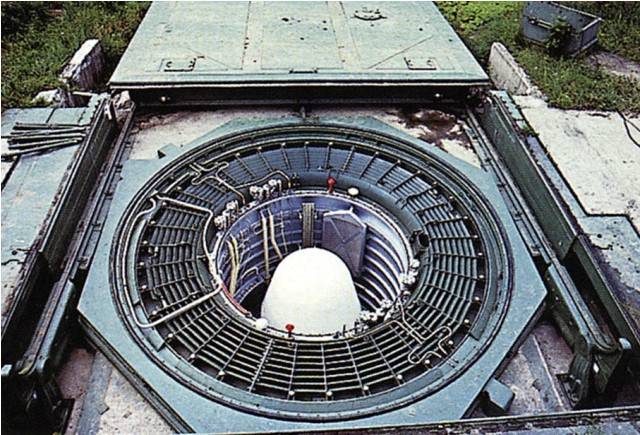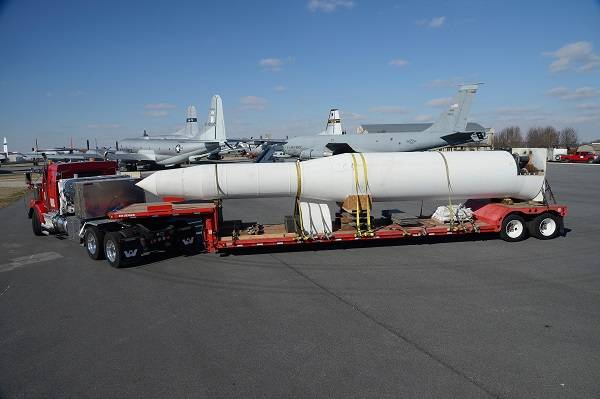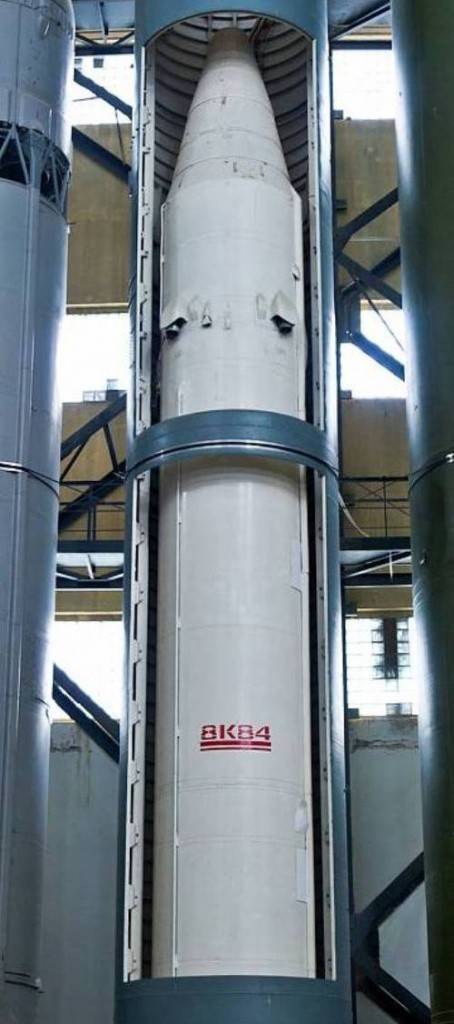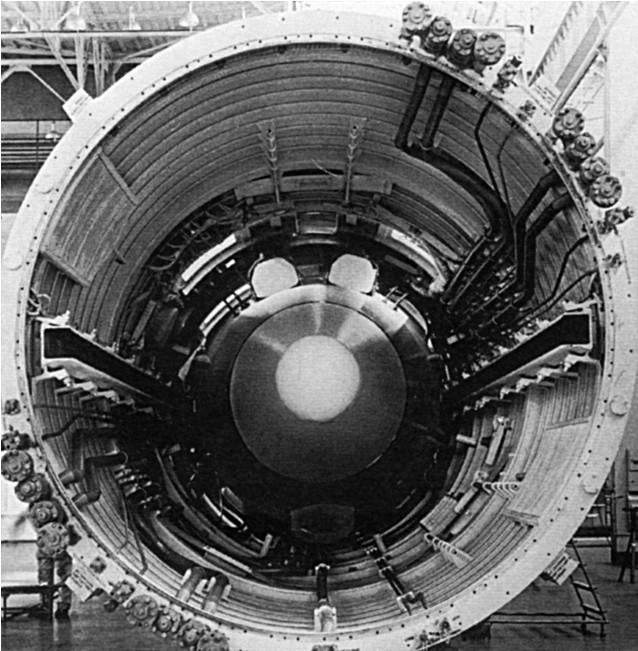UR-100: as General Secretary Khrushchev chose the most massive rocket strategic missile (part 1)

Missile UR-100 in the mine launcher with an open TPK. Photo from http://www.arms-expo.ru
Among the many legendary samples of domestic weapons a special place is occupied by those who have become the most massive. Trilinear rifle, Kalashnikov assault rifle, T-34 tank, Il-2 attack aircraft, MiG-15 and MiG-21 fighters ... Surprisingly, but in the same series you can add examples that are much more technically complex - such as, say, underwater 613 project boats, which became the most popular in stories domestic fleet. Or, for example, the UR-100 intercontinental ballistic missile, it is also 8K84, it is also the SS-11 Sego, which has become the most massive missile of this class in the Russian Strategic Missile Forces.
This rocket was in many ways a landmark for the Soviet Strategic Missile Forces, and for the Soviet rocket industry as a whole. The first large-scale intercontinental ballistic missile is her. The first rocket, which became the basis of the ballistic missile complex built on the principle of "separate start" - this is it. The first ampoule rocket, which was fully assembled right at the factory, was placed in the transport and launch container in the same place and in it fell into the silo launcher, in which she was constantly on duty, she too. Finally, the UR-100 was the first rocket in the USSR, the preparation time for which to launch was the shortest - it was only three minutes.
All this, as well as the great modernization capabilities of the UR-100 rocket, allowed it to remain in service for almost thirty years. The official start of work on the creation of this rocket was set by a joint resolution of the Central Committee of the CPSU and the USSR Council of Ministers on 30 in March 1963, 8 was adopted on July 84 in 21 missile system, the last missiles of the "hundredth" family were removed from combat duty in 1967, and destroyed - in 1994.
Our answer to "Minuteman"
In order to understand where the history of “weave” originates from - that is exactly what the ballistic missiles of the UR-100 family were called in the Soviet rocket forces and at the enterprises associated with their development and production - you need to assess the situation with strategic nuclear parity at the beginning of 1960's in the world. And it developed in a very unpleasant way for the Soviet Union. The country that was the first to create an intercontinental ballistic missile P-7 and launch with its help the first artificial satellite of the Earth, alas, quickly began to lag behind its main competitor in this area - the United States.

Intercontinental ballistic missile "Minuteman". Photos from http://www.dover.af.mil
Despite the success with the creation of the P-7, the USSR was late in putting this missile on combat duty. G7 launched only 15 on December 1959 of the year, and the American Atlas, which was its direct competitor, a month and a half earlier, on October 31. In addition, the US Air Force at a very high rate increased its grouping of ballistic missiles. By the middle of 1961, the Atlas 24 missiles were already on duty in the United States.
In addition to the Atlas, the same high rate in America was the deployment of a group of intercontinental ballistic missiles "Titan", adopted for service a year later. Two-level "Titans", created almost in parallel with the "Atlas", were more reliable and perfect in design. And therefore they deployed them much more: by the 1962 year, 54 rockets took up combat duty, and not at open launch sites, like the Atlas or P-7, but in underground mine launchers. This made them much more secure, which means that the US even more strengthened the first stage of the nuclear missile race.
Alas, the Soviet Union could not immediately respond to this challenge. By 30 March 1963 of the year, that is, by the official start of the development of the UR-100, the entire 56 intercontinental ballistic missiles of all models were on combat duty in the Soviet Union. And with the appearance in the United States of the first rocket of the so-called second generation - the solid-fuel two-stage LGM-30 Minuteman-1 - the speed with which this advantage grew, became completely unacceptable. Much simpler in the production and operation of "Minutemen" could be deployed no longer by the dozens, but by the hundreds. And although the American concept of nuclear war suggested the possibility of a massive nuclear retaliatory strike, rather than a preventive one, the adoption of the Minutemen could make the US military leadership revise these provisions.
That is, with a huge margin in favor of America, and nuclear parity developed in the early 1960-x. And the Soviet Union was looking for any opportunity to change such an unpleasant balance of power. However, in reality, there was only one possibility - to follow the same path that, as far back as the middle of 1950, US Colonel Edward Hall, US Air Force colonel, prompted American missilemen, who asserted that "quantity always beats quality." Soviet rocket forces needed a rocket that was as easy to manufacture and maintain as a three-line rifle - and just as massive.
P-37 vs. UR-100
Information that America began to produce and deploy a mass intercontinental ballistic missile reached the Soviet leadership, if not immediately, then with a slight delay. But Nikita Khrushchev didn’t have anything left to do the same in the Soviet Union — until now, such tasks were simply not set for domestic rocket engineers.
However, there was nowhere to go - the rapid growth of the group of American intercontinental ballistic missiles required an adequate response. The well-known scientific research institute-88, the leading national institute for the development of problems related to rocket technology, was involved in working out possible solutions to these problems. During 1960-61, the institute's specialists, examining all the data at their disposal - including those obtained with the help of Soviet intelligence, came to the conclusion that the Russian Strategic Missile Forces need to rely on a kind of duplex system - not to develop only “heavy” ICBMs with an almost unlimited range and powerful warheads, but also “light” ones that can be mass-produced and which ensure the effectiveness of a volley due to the large number of warheads simultaneously reaching the target.

Split mockup of the 8K84 rocket in the transport and launch container. Photo from http://www.arms-expo.ru
Not all missile specialists supported the theoretical calculations of the SRI-88. But very soon, information began to arrive that it was in this direction that the United States went along, adding light Titans, including Titan II, the only American liquid rocket that had been ampulled. This meant that she got up on combat duty fully charged, and at the same time had a very short preparation time for the launch - just 58 seconds. It became clear that the proposals of the scientific research institute-88 are not just justified, but quite fair, and should be taken for their implementation.
First, the project was presented by OKB-586 specialists under the leadership of Mikhail Yangel, who in 1962 developed two versions of the small-rocket project - a single-stage P-37 and a two-stage P-38. Both were liquid, both were ampu lated, made it possible to keep them in combat readiness for up to ten years and at the same time provided for automatic control and the use of a “single start”. This option was much more efficient and easier to maintain than all the Soviet ICBMs, which at that time were in service with the missile forces.
But the standard practice of developing armaments in the Soviet Union provided for each topic to have at least two developers - this is what socialist competition looked like. Therefore, very soon a resolution of the USSR Council of Ministers, signed by Nikita Khrushchev, appeared, which was called “On rendering OKB-52 assistance in the development of launch vehicles”. This document provided for the transfer of the OKB-586 to the KB, which was led by Vladimir Chelomey, of the design documentation and three ready-made P-14 missiles. The formal reason for this decision was the creation of a universal missile UR-200, the development of which Chelomey led from 1959 of the year and which was considered as a single carrier for various combat and reconnaissance tasks. But since there was no experience in the development of rockets from the OKB-52, and support from Khrushchev was, the easiest way to spur the process of creating the "two hundred" was the transfer of other rocket engineers to his disposal.
After the release of the resolution, a group of engineers from the Vladimir Chelomey design bureau arrived at Mikhail Yangel’s design bureau for specified documents. And soon, in the depths of OKB-52, a project was born, named UR-100 - by analogy with UR-200. It was a "light" or, as they said, a small-sized rocket, which could also be used as a universal carrier, but for lighter loads. In addition, if the “two-hundred” was supposed to be used in the anti-satellite defense system, then the “weave” of Vladimir Chelomey suggested adapting it to the national missile defense system.
The start of rocket rivalry
Until the end of 1962, both the design bureaus completed a preliminary study of their “light” missile projects, and the solution of the issue passed to the political plane - to the level of the CPSU Central Committee and the Soviet government. Thus began the competition between the two famous rocket design bureaus, which eventually turned into the victory of Vladimir Chelomey. It was intense and dramatic - so much so that the degree of passions can be judged even by the dry lines of official documents and the memories of those directly participating in the events.

Training missile UR-100 at the November parade in Moscow. Photos from http://kollektsiya.ru
The rapid development of events began soon after the New Year. January 19 Deputy Chairman of the Council of Ministers of the USSR, Chairman of the Commission of the Presidium of the Council of Ministers on Military Industrial Affairs Dmitry Ustinov, Minister of Defense Marshal of the Soviet Union Rodion Malinovsky, Chairman of the State Committee on Defense Technology Leonid Smirnov, Chairman of the State Committee of the Council of Ministers on Radio Electronics Valery Kalmykov, Chairman of the State Committee of Council of Ministers in chemistry, Viktor Fedorov and Commander-in-Chief of the Strategic Missile Forces Sergey Biryuzov sent a letter to the CPSU Central Committee:
“Owls. top secret
Central Committee of the CPSU
In accordance with the instructions, we, with the involvement of scientists and specialists, reviewed the proposals of the main designers of TT. Makeeva, Isaeva, Yangel and Reshetnev on the development of compact ampoule-type missiles with an autonomous control system.
The creation of this type of missile will be a further step in the development of rocket technology. The design of rockets provides for the possibility of staying in the mine in the mine for 10 years, instead of 30 – 90 days of existing rockets, and the widespread introduction of automation of the processes of preparing and launching rockets (remote control) significantly reduces the number of service personnel and reduces the availability time from 1 to 5 minutes (existing - 15 – 30 minutes), which significantly increases the combat readiness of missile weapons.
According to the operating conditions and the simplicity of the starts, the indicated qualities bring the ampoule rockets closer to the solid-propellant missiles, and in terms of the power to the engines and dimensions, they will have advantages.
Based on the State Committee on Defense Technology conducted in SKB-385, OKB-10 and OKB-586, we consider it expedient to support the proposals of the main designers on the development of 1963 – 64. one automated missile system with a small-sized rocket R-37 ampoule type with a firing range in the range from 2000 to 12 000 km, instead of the proposed two missiles at a range 4500 and 12 000 km, but with two versions of combat heads: the range 12 000 km with special charge ... in TNT equivalent and at an intermediate range of 4500 km with special charge ...
Please approve the draft resolution of the Central Committee of the CPSU and the Council of Ministers of the USSR on this issue. ”
The names of the designers mentioned in this letter require clarification. Viktor Makeev - at that time the chief designer (from 1957 of the year), and soon the head of SKB-385, who developed and manufactured ballistic missiles for Soviet submarines. Alexey Isaev is the head of OKB-2, Scientific Research Institute-88, who developed liquid rocket engines and the theory of their work. And Mikhail Reshetnev, head of the OKB-10 (shortly before the former branch of the OKB-1, Sergey Korolev), since November 1962, was engaged in the creation of a light-class launch vehicle transferred to him from the Yangelev OKB-586. In a word, all the experts mentioned in this letter are representatives of organizations directly connected with the State Committee for Defense Equipment, directly subordinate and directly supervised by Dmitry Ustinov.
But eleven days later, on January 30, according to the results of the meeting of the USSR Council of Defense, Protocol No. 30 is adopted, in which there is such a point:
“On the creation of 1963 – 64. intercontinental missile complex with an ampoule rocket and a simplified mine launch
Agree with the proposal of the Ministry of Defense (t. Malinovsky, Zakharov, Biryuzov) about the need to create in 1963 – 64. an automated missile system with an intercontinental ampullah rocket and a simplified mine launch.
To charge Kozlov F.R. (convocation), Brezhnev L.I., Ustinov D.F., Zakharov M.V., Biryuzov S.S., Serbin I.D., Smirnov L.V., Dementiev P.V. to consider the status of the works of the chief designer of the t. Yangel M.K. and the general designer t. Chelomey V.N. and in two weeks to submit proposals to the Central Committee of the CPSU on the creation of an automated missile system with an intercontinental ampoule rocket and a simplified mine launch.
Listening and discussion of reports TT. Chelomeya V.N. and Yangel M.K. spend February 11, 1963 in OKB-52 of the State Committee of the Council of Ministers of the USSR aviation technique. "
This document completely changes the balance of power in the race of the creators of the “light” intercontinental ballistic missile. After all, Vladimir Chelomey is mentioned for the first time on equal terms with Mikhail Yangel, and Peter Dementyev, the head of the State Aviation Engineering Committee (former and future USSR Ministry of Aviation), is directly included in the number of government officials of the highest rank who are authorized to influence the fate of this rocket. OKB-52. In addition to him, the decision-makers include two more key people - Leonid Brezhnev, who will replace Nikita Khrushchev as the leader of the Soviet Union a year later, and Frol Kozlov, second secretary of the CPSU Central Committee and one of the most loyal members of the party. And since the acting head of the USSR openly favored Vladimir Chelomey, these people clearly had to provide support for the UR-100 project as opposed to P-37 and P-38.

Missile UR-100 in the transport and launch container, without sealing. Photo from http://www.arms-expo.ru
"The rockets were like one another"
This political deck was played on the agreed date, February 11, at a meeting at the OKB-52 branch in Moscow’s Filas. In the memoirs of the participants of those events, and in conversations of people who had no direct relation to them, but related to the missile industry of the USSR, she received the name “Council in Fili” - according to an obvious association. This is how Sergey Khrushchev, the son of the then head of the USSR, talks about her in his book of memoirs “Nikita Khrushchev. The birth of a superpower ":
“Yangel and Chelomey reported. Both have just finished a sketch study. The court presented the calculations, layouts and layouts. It was necessary to choose the best option. Not an easy task, the rockets were extremely similar to one another. It happened more than once in technology. The same level of knowledge, the general technology. Unwittingly designers come similar thoughts. Externally, the products are obtained almost twins, differ prisoners inside the "raisins".
Each of the projects had supporters, their fans, both among the military and among officials of various ranks, right up to the top - the Council of Ministers and the Central Committee.
The first was Yangel.
Rocket P-37 turned out elegant. She could hit point targets and for a much longer time be at the starting position in the refueled state. As in all previous developments, high-temperature components of the fuel and oxidant based on nitrogen compounds were used here. But now Yangel seemed to have found a solution on how to tame all the corrosive acid. The message was convincing. But is it only two such laborious and important projects that the country's security depends on - the Р-36 and Р-37? Is it reasonable to put all the eggs in one basket? But this is the concern of the Government, not the Chief Designer.
After answering numerous questions, Yangel sat down.
The next was Chelomey. The main task he sought to solve in the new development, called the UR-100, is the long-term autonomy of the rocket and the full automation of its launch. Until these problems are resolved, the mass deployment of intercontinental missiles on duty will remain a utopia. If we keep the technical decisions adopted for today, then all the technical and human resources of the country will be needed to service the missiles.
<...>
“In recent years, a lot of experience has been gained with nitrogen compounds,” Chelomei went on to the main thing. - Despite all the negative sides, we have learned to work with them and, having shown some engineering ingenuity, we will be able to subordinate them to ourselves. Let the Americans are engaged in gunpowder, we will bet on acid.
Special processing of the insides of the tanks, a system of especially resistant pipelines, tricky membranes - all this, assembled into a multi-stage scheme, provided the rocket with many years (up to ten years) safe storage and instantaneous initiation at a given moment.
“Our rocket,” continued Chelomey, “is somewhat similar to a sealed ampoule, its contents are completely isolated from the outside world until the term, and at the very last moment, at the“ start ”command, membranes will break through and components will rush into the engines. As a result of the measures taken, despite so formidable contents, during the period of duty it is as safe as solid fuel.
Chelomey fell silent. Judging by the reaction of the majority of members of the Defense Council, Chelomey won.
And his father clearly sympathized with him. Dementiev smiled triumphantly, Ustinov stared gloomily before him. The report was followed by endless questions. Chelomey answered confidently, clearly. It was felt that he suffered a rocket.
<...>
After lunch, gathered again in the conference room. There was a discussion and decision making. Started with rockets. To give preference? At dinner, my father spoke with Kozlov and Brezhnev on this topic. He liked Chelomey’s proposals, and the rocket design bureaus from the state were loaded rationally: heavy P-36 - to Yangel, and let his rival, light UR-100, project - but he wanted confirmation.
<...>
Kozlov and Brezhnev supported the father. At the meeting, the father spoke in favor of Chelomey. Nobody began to talk to him. Yangel looked just dead. Ustinov was upset. Wishing to support Mikhail Kuzmich, his father began to speak kind words about his great merits, about the importance of working on the 36 th rocket, about state interests requiring dispersal of efforts. The words did not comfort, but only stirred up the wound. ”
Продолжение следует ...
Information